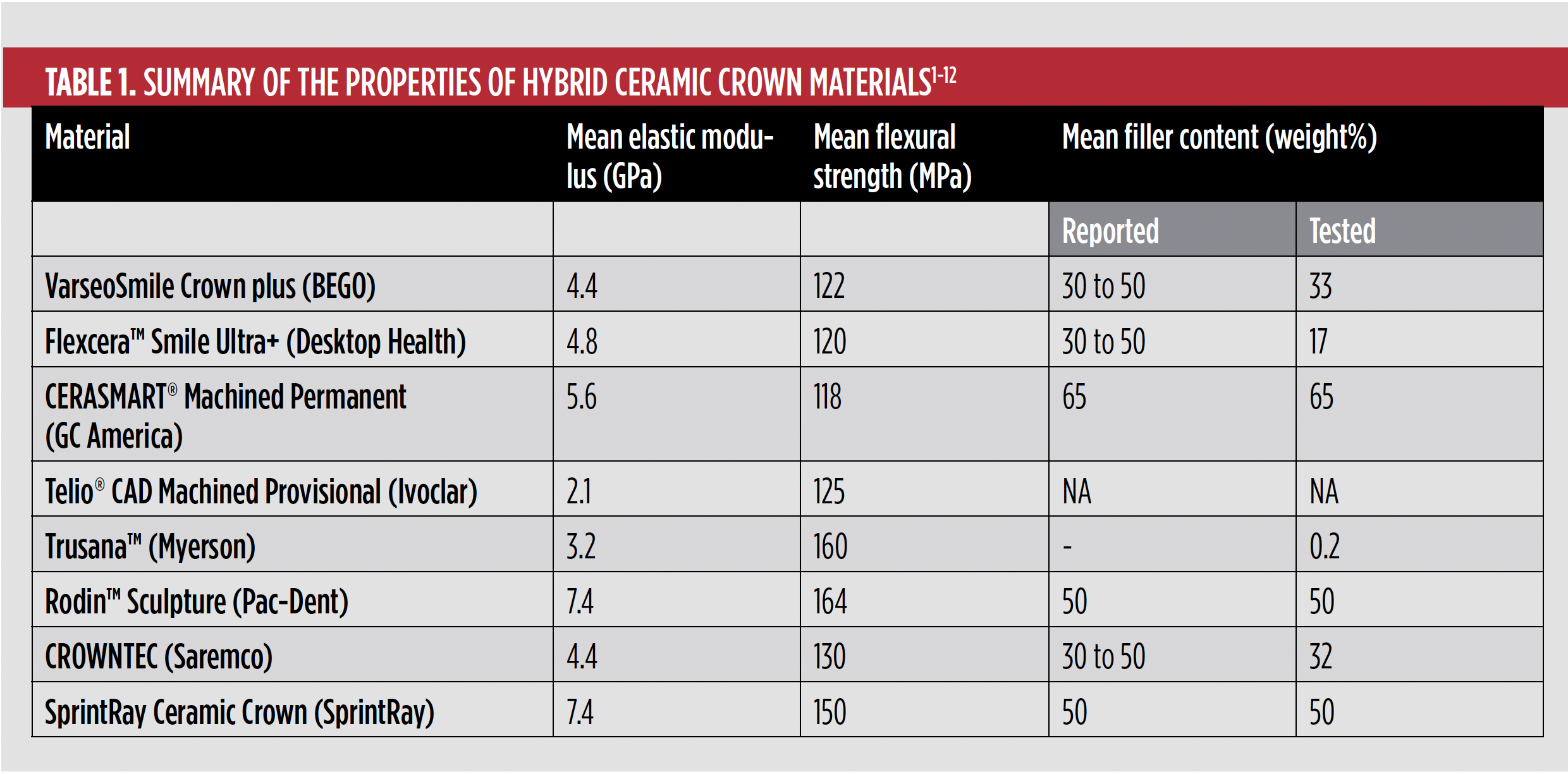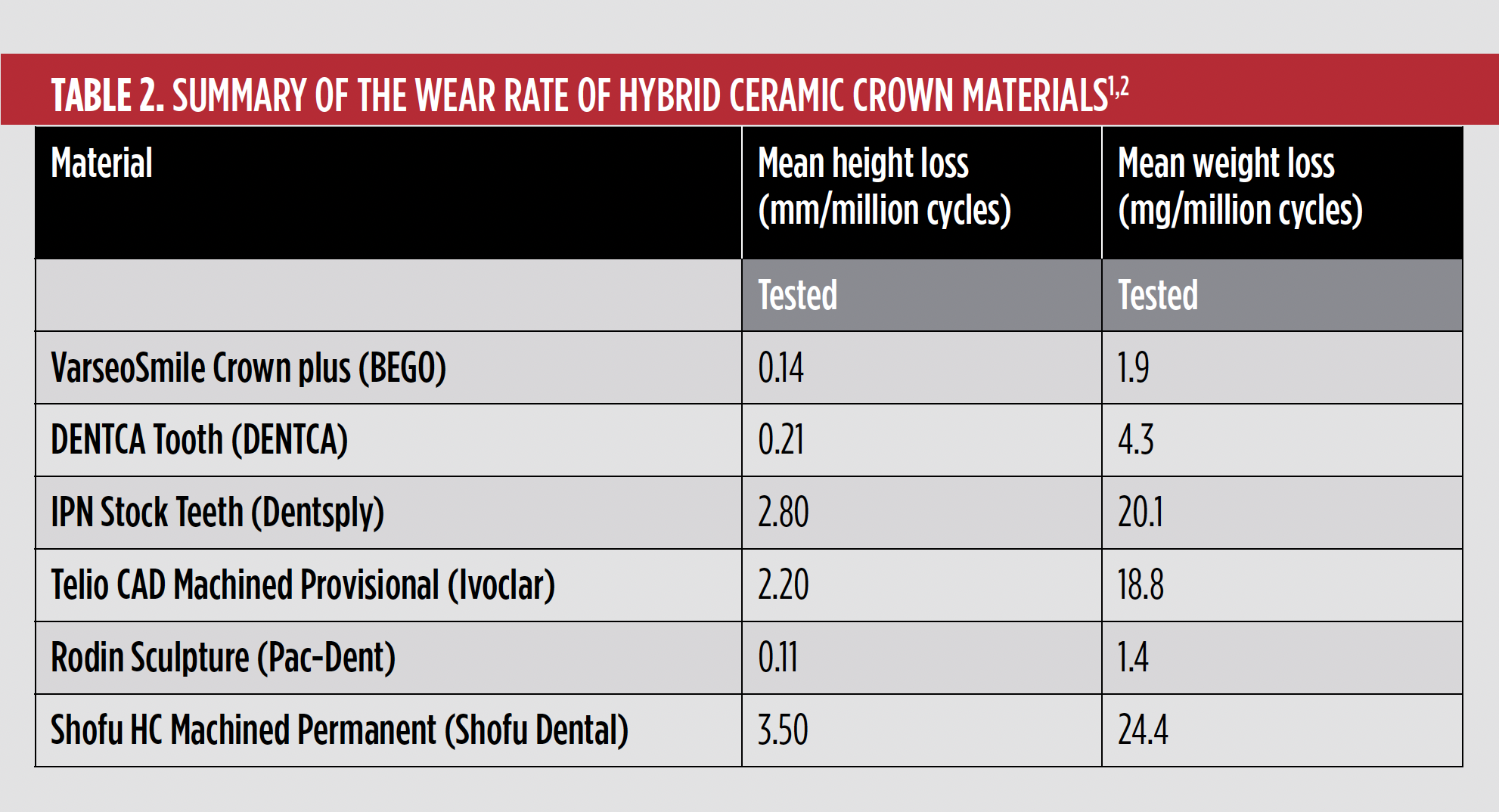Properties of Hybrid Ceramic Crown Materials
Independent laboratory testing investigates mean filler content and wear rates
Russell A. Giordano II, DMD, DMSc
There is limited data available for many of the new materials for 3D printing. The mechanical properties of a variety of these materials, which were obtained from manufacturer self-reported data and independent research, are summarized in Table 1.1-12 In looking at the literature, the filler content values of many of these materials are reported by the manufacturers as a range of 30% to 50%. Assuming that this is weight%, many of these materials may not actually meet the ADA criteria. The data reported in the “Tested” column was obtained during research conducted at the Boston University Henry M. Goldman School of Dental Medicine.
There is also very limited data on the wear rate of hybrid ceramic materials. One study that performed 400,000 wear cycles using a University of Alabama at Birmingham (UAB) type in vitro wear tester determined that the volumetric wear of hybrid ceramic materials ranged from 0.012 mm3 to 0.019 mm3, depending on their composition.3 The wear rates of some of these materials, which are presented in Table 2, were obtained in the laboratory at the Boston University Henry M. Goldman School of Dental Medicine.
The Boston University Henry M. Goldman School of Dental Medicine wear tests were performed with a device with a pin on plate design that is similar to the UAB system. Plates of Vita MKII, which has been shown to wear at a similar rate as tooth enamel by both in-vivo and in-vitro tests, are on the bottom of the device and pins of test material are on the top and weighted. The pins of test material are approximately 3.5 mm in diameter and 5 to 6 mm in height. They are bonded to metal rods that are weighted with a 400 g load. The pins are moved in a slight arc motion across the plates for 200,000 cycles while a continuous flow of water is used to remove wear debris. Then, the pins are weighed, and their height is measured with a dial micrometer.
References
1. Behbehani Y. Mechanical Properties of Printable and Machinable Denture Tooth Material. [Master’s thesis]. Boston, MA: Boston University; 2022.
2. AlSarraf HA. Mechanical and Optical Properties of Machined, Printed, and Conventional Dental Polymers. [Master’s thesis]. Boston, MA: Boston University; 2021.
3. Ahmed A, Bora P, Lawson N, et al. Comparing wear and flexural strength of 3D-printed denture teeth materials. J Dent Res. 2023;102(Spec Iss A):abstract 0397.
4. Jain S, Sayed ME, Shetty M, et al. Physical and mechanical properties of 3D-printed provisional crowns and fixed dental prosthesis resins compared to CAD/CAM milled and conventional provisional resins: a systematic review and meta-analysis. Polymers (Basel). 2022;14(13):2691.
5. Flexcera Smile Utra+. Desktop Metal website. https://health.desktopmetal.com/3d-printers/materials/flexcera/. Accessed June 8, 2023.
6. Sprintray Ceramic Crown Scientific Studies. SprintRay Inc., 2023. Accessed June 8, 2023
7. Saremco Crowntec Technical Data Sheet and Product Flyer. Saremco website. https://www.saremco.ch/en/downloads/catalogs-flyers-flow-charts/. Accessed June 8, 2023.
8. Trusana Product Flyer. Myerson LLC website. https://www.mytrusana.com/. Accessed June 8, 2023.
9. Bego Varseo Smile+. BEGO GmbH & Co. KG website. https://www.bego.com/3d-printing/materials/varseosmile-crown-plus/. Accessed June 8, 2023.
10. Cerasmart Product Brochure. GC America website. https://www.gc.dental/america/resources-and-ifu. Accessed June 8, 2023.
11. Rodin Sculpture. Pacdent Inc. website. https://pac-dent.com/products/3d-printing-materials. Accessed June 8, 2023.
12. Mechanical and Physical Properties of Printed Crown Materials [Master’s thesis in progress]. Boston, MA: Boston University; 2023.





